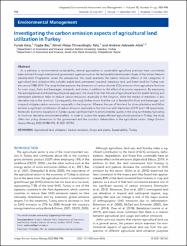Investigating the carbon emission aspects of agricultural land utilization in Turkey
Özet
As a pathway to environmental sustainability, several approaches to sustainable agriculture practices have consistently
been echoed through international government agencies such as the Sustainable Development Goals of the United Nations
Development Programme. Given this perspective, this study examines the carbon emission effects of the categories of
agricultural land utilization (this includes arable land, permanent cropland, meadows land, and forest land) for Turkey over
the period 1988–2019. The study further explores the dimension of carbon dioxide (CO2) emission from agricultural land use
for sown crops, fruits and beverages, vineyards, and olives, in addition to the effect of economic expansion. By employing
the autoregressive distributed lag empirical approach, the study finds that the use of agricultural land for arable farming and
permanent plantation helps to reduce carbon emissions, especially in the long‐run, while the impact of meadows is also
desirable only in the short‐run. Consequently, the study further shows that the use of farmland for fruits and beverages, and
vineyard mitigates carbon emission, especially in the long‐run. Whereas the use of farmland for olives plantation and fallow
exhibits a significant contribution of carbon emission, especially in the short‐run with elasticities of 0.91 and 1.48 respectively.
Moreover, economic expansion in Turkey causes significant harm to environmental quality in the long‐run thereby truncating
its short‐run desirable environmental effect. In order to sustain the largely efficient agricultural practice in Turkey, the study
offers two policy dimensions to the government and the country's stakeholders in the agricultural sector.
Cilt
18Sayı
4Bağlantı
https://hdl.handle.net/11363/5274Koleksiyonlar
Aşağıdaki lisans dosyası bu öğe ile ilişkilidir:


















